Fun Fact: The first DApp on Ethereum was a prediction market
Initially, it was an extremely imaginative product.
Initially, it was an extremely imaginative product.
Written by: Eric, Foresight News
While recently organizing a list of Web3 prediction markets, I suddenly remembered Augur. After searching for related information, I found that Augur announced it would relaunch in March this year, but I had no idea when it had stopped operating.
The reason for this sentiment is that Augur was the subject of the first article I translated when I entered the industry. The article was published on March 19, 2019, and I still remember the requirement at that time was to add my personal understanding on top of the translation. I also recall that I used the movie poster of "The Butterfly Effect" as the cover for the article published on WeChat, because my personal understanding was that prediction markets have the power to change the future.
I don't know if the view I had on a whim more than six years ago could be considered prophetic, but my opinion on why the leading Web3 prediction markets now have valuations close to 10 billions of dollars remains unchanged: when an event will definitely have a deterministic result in the future, and the game over this result is mixed with economic interests, the game itself will have the ability and motivation to change the final outcome.
The First DApp on Ethereum
Augur is almost unrivaled in terms of being "early." Because Ethereum is a permissionless network, it's hard for me to verify whether Augur was truly the first DApp on Ethereum, but some things are certain. For example, Augur started development on Ethereum's testnet before the mainnet was even live, and it was the first project to truly attract the attention of the then-nascent industry, which wasn't even called "Web3" yet. Many subsequent ecosystem projects followed. Although Augur officially launched in 2018, calling it "the first DApp on Ethereum" is not an exaggeration.
This timing is almost absurdly early: Ethereum's genesis block was born on July 30, 2015, and the ERC-20 standard was only officially proposed in November 2015. This means that when Augur initially sold REP tokens, REP did not conform to the ERC-20 standard.
At that time, Augur successfully raised over $5 million. In 2015, the price of bitcoin was only $300 to $400, and Ethereum dropped as low as $0.4 that month. More than eight years ago, in a Reddit discussion titled "What was the first token to run on an Ethereum smart contract?", a user named x_ETHeREAL_x said that at the time, there were no wallets or GUI interfaces for Ethereum, and you had to use the Geth client and command line to "send money." Someone quickly corrected this, with user adrianclv stating that there was no Geth client yet, and what was used was the CPP Ethereum client developed by Ethereum co-founder and later Polkadot founder Gavin Wood.
Carrying the Torch, but a Poor User Experience
After nearly three years, in July 2018, Augur officially launched.
When Augur was officially released, it provided both a PC desktop application and a web application. The reason for launching a PC application was that there were few Ethereum nodes at the time, and using an application with a built-in full node might be more efficient. The team behind Guesser, an Augur ecosystem project, described the design of the desktop app as follows:
Augur App is a lightweight Electron application that bundles Augur UI and Augur Node together and deploys them on your local computer. Augur UI is a reference client (similar to Geth for Ethereum) used to interact with Augur's core protocol smart contracts on the Ethereum blockchain. Augur Node is a locally running program that scans the Ethereum blockchain for Augur-related event logs, stores them in a database, and provides the corresponding data to Augur UI.
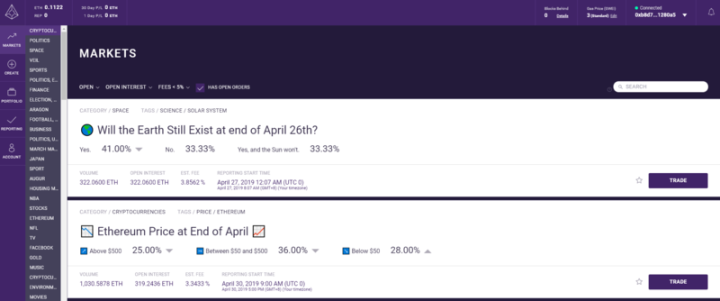
Although there were other projects at the same time, such as the earliest NFT project Crypto Kitties and pure gambling applications like Fomo3D, Augur was still considered the "coolest kid" in the industry. In addition to truly implementing prediction market functionality on-chain, Augur also developed its own decentralized oracle to provide results, and this proprietary oracle went live nearly a year before Chainlink's oracle.
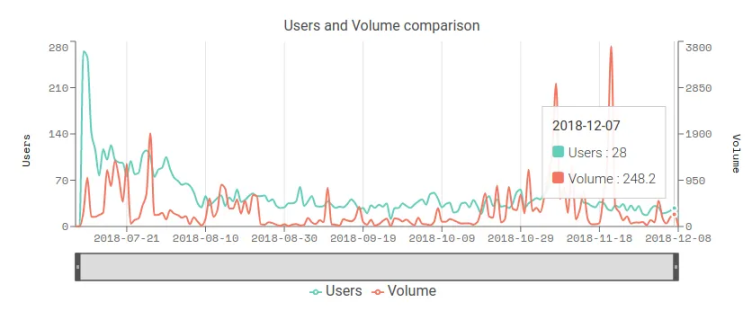
According to DappRadar data, when Augur first launched, its DAU peaked at 265, but by August 8, this number had dropped to 37, and by the end of the year, daily active users were less than 30. As of December 11, 2018, there were a total of 1,635 markets created on Augur, 11,825 orders, and 6,331 completed trades. During the 2018 U.S. midterm elections, there were more than 200 trades in a single day. These numbers may seem insignificant now, but they were considered good results at the time.
Moreover, if you understand Augur's implementation mechanism, you'll find it a miracle that dozens of people were still playing and thousands of orders were completed.
To say Augur had a poor user experience is an understatement. Besides the generally poor experience of wallets like MetaMask at the time, Augur's own design also had fatal flaws. First, unlike Polymarket, Augur did not design arbitrage opportunities to automatically balance probabilities, but instead required direct one-to-one matching. In an era without market makers, you had to find someone whose opinion was exactly the opposite of yours.
Take the second market on the trading interface as an example. The topic was ETH's price at the end of April 2019, with three options: less than $50; between $50 and $500; greater than $500. If you chose the second option to bet, you would see this page:
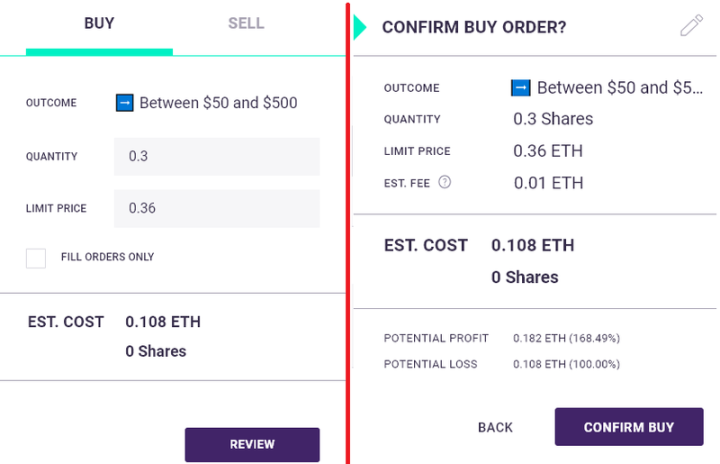
Users needed to select the number of shares and the specified price (probability). The number in the image means betting 0.3 shares, believing there is a 36% probability that the final price will fall between $50 and $500, for a total cost of 0.108 ETH. Like Polymarket, Augur also had an order book, but the two order books were completely different in meaning.
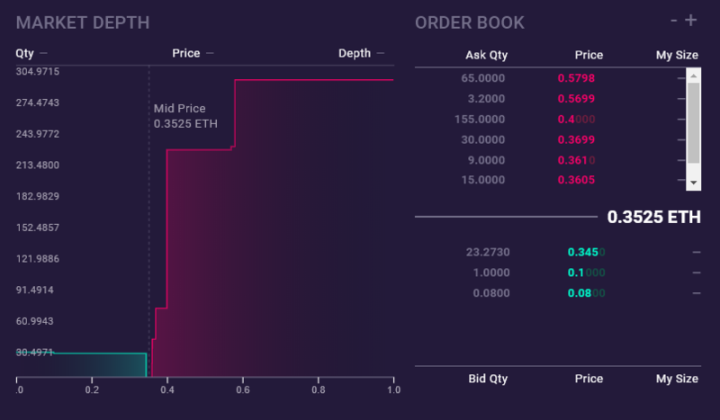
The lowest sell price shown in the image is 0.3605, which does not mean someone thinks there is a 36.05% chance the price will not fall within the $50 to $500 range, but rather that there is a 63.95% chance it will not be in that range. So when you want to bet the opposite way, you need to calculate the probability yourself, otherwise you may not be able to match the order. The order you just placed requires someone who believes or is willing to believe there is a 74% chance it will not be in this range, so the two sides can match and, after the final result, take the other's chips.
This is where things get confusing: for each option, Augur only has a "Yes" choice, and users must choose to go long "Yes" or short "Yes."
Augur's permissionless nature led to many invalid markets. For example, the end date of the above market might be set in mid-April, and the oracle network's results could be challenged multiple times. This meant that markets that should have settled quickly were dragged out for nearly five months, closing only after countless disputes. Combined with the need to find a "well-matched" opponent, only 6,331 out of 11,825 orders were completed.
Finally, using Augur was surprisingly expensive. In addition to gas fees and fiat-to-ETH conversion fees for users not used to wallets, both the oracle reporters and market creators had to stake REP, and users had to pay fees to both parties.
Although the fees charged by market creators and reporters are relatively low (1-2%), users must pay multiple layers of fees to use the platform, which add up to a considerable amount. In Augur, these fees, from low to high, are: reporting fee (0.01%), market creator fee (1-2%), Ethereum gas fee (depending on order size), and fiat-to-ETH conversion fee (Coinbase charges 4% for debit card payments and 1.5% for ACH payments). Therefore, the total transaction fees on Augur range from 3.5% to 9% or even higher.
Poor wallet experience, one-to-one matching, logical loopholes, and high fees made it difficult for Augur to scale, but this did not affect its almost "founding father" status in the history of Ethereum and DApp development. Many members of the team that developed Augur have now become pillars of the industry.
Team Infighting, Ousted Member Sues for $150 Million
Augur was launched by the Forecast Foundation. Public information shows that the organization included co-founder and core developer Jack Peterson, co-founder and chief architect Joey Krug, early marketing and community lead Jeremy Gardner, full-stack engineer responsible for frontend and contract integration Stephen Sprinkle, and researcher Austin Williams, who wrote the game theory appendix for the Augur white paper.
Among them, Joey Krug has served as co-chief investment officer at Pantera Capital since June 2017 and is now a partner at Founders Fund. Stephen Sprinkle left Augur in 2019 to join ConsenSys as a product manager, then became director of engineering at BlockFi, and after BlockFi's 2022 restructuring, moved to Coinbase to continue working on institutional products.
But in fact, a lawsuit filed by Matt Liston in 2018 revealed a story from before Augur's birth.
According to a 2018 report by Blockcast, Matt Liston said he first registered a company called Dyffy in Delaware, USA, and hired Jack Peterson. At the time, Liston proposed developing a prediction market on the blockchain, but Peterson was initially unsupportive.
Later, Liston read the Truthcoin white paper by Yale economist Paul Sztorc and thought it could be used as a basis to develop a prediction market and issue tokens. Liston successfully convinced Joseph Ball Costello to invest and also persuaded Peterson, through Paul Sztorc, to support the idea of on-chain development. With this foundation, Liston hired Joey Krug and Jeremy Gardner, the latter of whom suggested naming the project Augur.
In the following months, the team argued endlessly over technical and business strategies, and the result was that Matt Liston, who had brought everyone together, was kicked out in October 2014. Krug replaced Liston as director, and Peterson became CEO. In December of the same year, the non-profit Forecast Foundation was established in Oregon, USA.
Matt Liston said that, possibly to sever ties with Dyffy, Costello repeatedly urged him to agree not to take legal action against Dyffy, acknowledge Dyffy's acquisition, and exchange equity for cash or REP tokens. Under continuous pressure, Liston was forced to sign the agreement and, allegedly "kept in the dark about the token allocation plan," gave up a 5% share of REP in exchange for $65,000 in cash. According to Augur's market cap at the time of the lawsuit, the tokens he gave up were worth more than $20 million.
For Augur, which then had a market cap of over $450 million, Matt Liston sought $38 million in general damages and $114 million in punitive damages, totaling $152 million—more than a third of Augur's market cap and the largest claim in crypto history at the time.
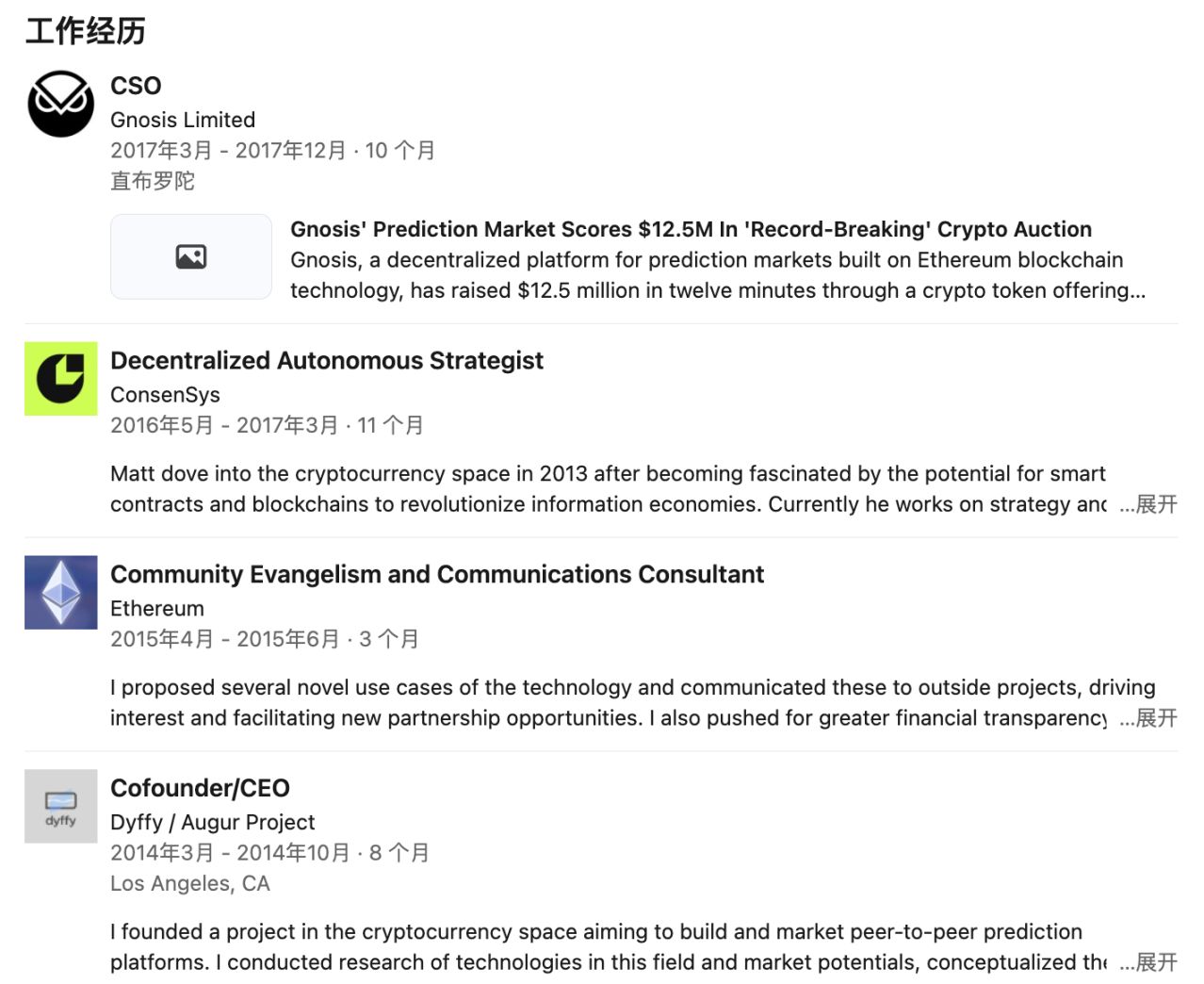
However, the Augur defendants were surprised that Liston suddenly reneged on the agreement three years after signing it. In addition, Jack Peterson and Joey Krug both claimed that Liston was not a founder of Augur. Krug said, "Liston has not contributed a single line of code to the open-source repository on GitHub or any other Augur repository. He can't be called a founder of Augur at all." The report said that doubts about his true identity left Liston struggling with unemployment, and his LinkedIn profile shows no new job records after resigning as chief strategy officer of Gnosis in 2017.
The report quoted insiders as saying the main reason for the infighting was that Liston advocated developing Augur on Ethereum, while the team insisted on developing it on bitcoin. Interestingly, Augur was ultimately launched on Ethereum and became the first successful project after Ethereum mainnet went live. Notably, there have been no further public updates on the case, and since Augur survived until the end of 2021, it was either resolved peacefully or simply faded away.
Three and a Half Years of Silence, Then a New Start
This March, Augur suddenly announced its return on X, and the last time this account tweeted was November 18, 2021.
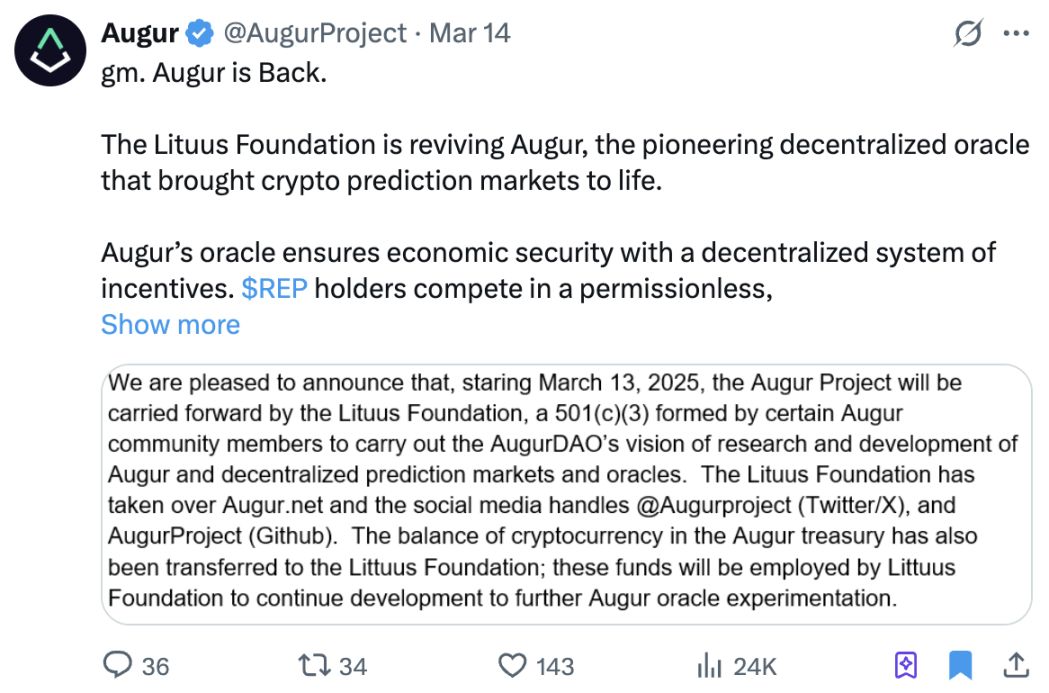
In 2020, Augur launched an updated v2 version, making adjustments to many aspects of the user experience. In July of that year, Forbes called it "a major leap forward in decentralized applications." In the article "Ethereum’s First ICO Blazes Trail To A World Without Bosses," Forbes reporter Michael del Castillo wrote, "It works like the internet, but without a trusted third party. If successful, this far-reaching upgrade will not be limited to betting on horse races without a bookmaker; it could mark a turning point for the next generation of the internet."
Although Augur saw a single market with over $10 million in participation during the 2020 U.S. presidential election, DeFi's brilliance was too dazzling, and Augur ultimately fell at the peak of the 2021 bull market. Perhaps Polymarket's breakout brought prediction markets back into the spotlight after nearly a decade, prompting the new team behind Augur to choose to restart this year.
Augur's relaunch will be handled by two teams: Lituus Foundation will be responsible for tokens, operations, and oracle development, while Dark Florists will be responsible for implementing the actual prediction market. Lituus Foundation claims to be composed of long-term Augur community members, but there is currently no information about its members.
Dark Florists, on the other hand, is a well-known Ethereum development team. Among its main members, Killari cracked an indistinguishability obfuscation (a cryptographic scheme that turns programs into "black boxes" that can be freely shared and executed but whose internal workings are completely hidden) implementation jointly developed by the Ethereum Foundation, Phantom.zone, and 0xPARC at Devcon 2024, winning a $10,000 bounty. Micah Zoltu is known for discovering a major vulnerability in MakerDAO in 2019 and is also the developer of EIP-3074 and EIP-2718.
This team's vision for the "new Augur" is not a purely commercial platform but, in the words of Lituus Foundation, a cross-chain decentralized truth machine. Lituus Foundation hopes to separate and modularize the oracle from Augur's prediction market so that all applications can use the Augur oracle.
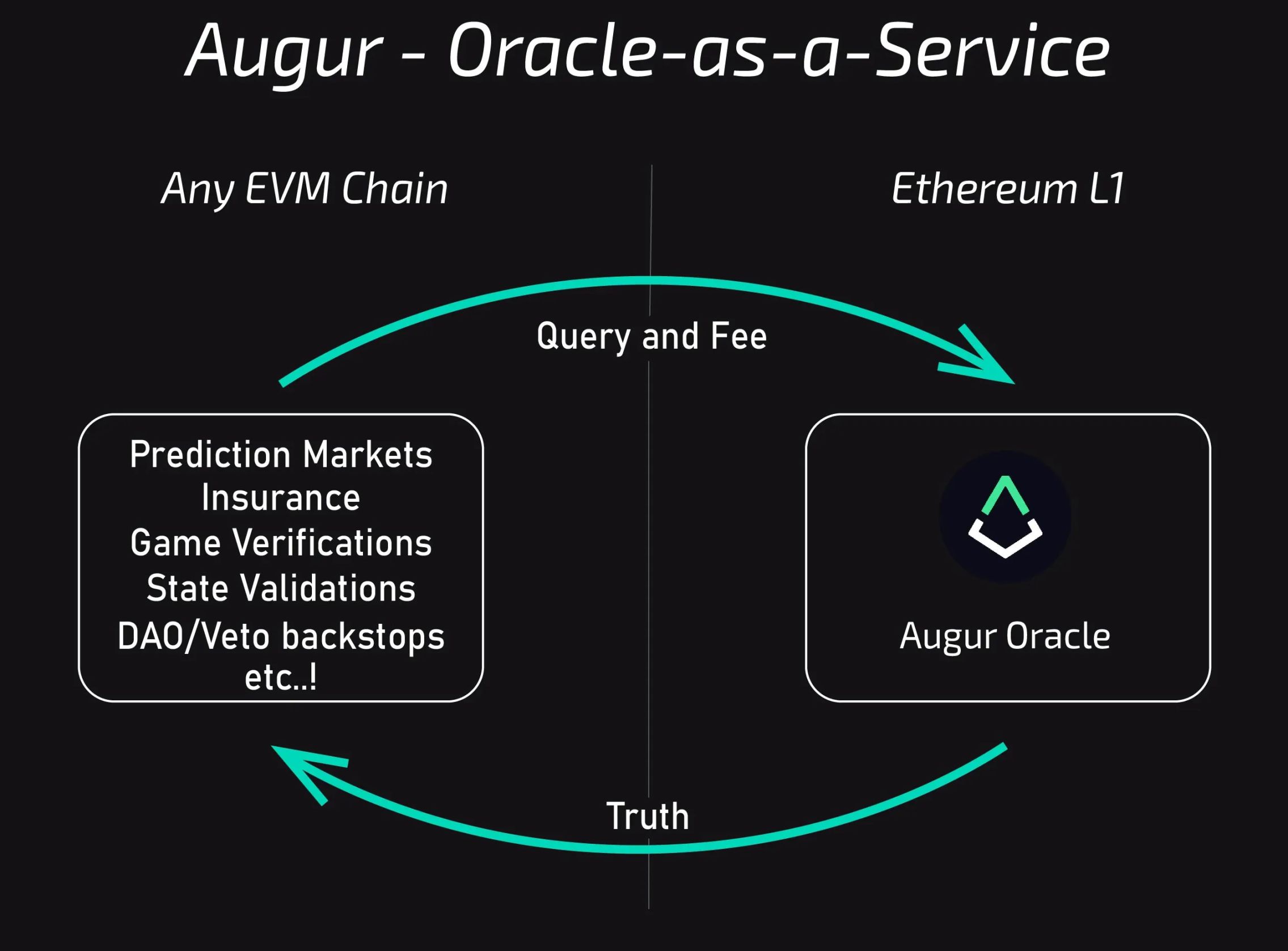
Augur was originally designed as a purely decentralized application, not relying on multisig, key management, or back-up mechanisms. Even its tokenomics incorporated original game theory designs to ensure the platform's normal operation through incentive mechanisms (this aspect was not explained earlier; interested readers can read the original Augur white paper and v2 update). The new Augur will still adhere to this spirit. The only information we have now is that the new oracle will most likely be deployed on L2, and the initial prediction market will be developed based on AMM.
So far, Lituus Foundation has released two progress reports. In the first quarter after announcing the relaunch, Lituus increased its REP holdings from 250,000 to 550,000, deployed $100,000 in liquidity on Uniswap v3, and planned to list on CEX. In the second quarter, there were four major developments:
- Launched the website;
- Oracle research will proceed along two complementary lines, one focusing on consumer prediction markets and the other on enterprise-grade oracle use cases;
- Micah Zoltu initiated a crowdfunding campaign to promote an algorithmic fork of REP to test Augur's core security model;
- The foundation expanded its buyback program to 1 million REP.
The algorithmic fork is a very interesting design, and the details are quite complex, so I'll give a brief explanation here:
In Augur's design, "results" have no fixed answer. Augur allows disputes over results by staking REP to vote. When a dispute reaches the threshold (2.5% of total REP staked), the system splits into two parallel universes, each corresponding to a result, and REP holders must choose the universe they support and migrate their REP there. If the staked REP does not reach the threshold within a given time after a dispute starts, participants supporting the initial result will be rewarded.
Micah Zoltu's crowdfunding campaign aims to raise funds to invest in obviously incorrect results during a dispute, thereby "sacrificing" some REP to test the mechanism's executability. However, because of this test, the plan to list on CEX was forced to pause and will only be discussed after the dispute is fully resolved.
Conclusion
"Time passes, and heroes are hard to come by."
In his article "From prediction markets to info finance" published last November, Ethereum co-founder Vitalik mentioned that he was once a loyal user and supporter of Augur. As Ethereum's first project, Augur's design still seems ahead of its time today.
This forward-thinking nature does not come entirely from its mechanisms, but from the fact that its implementation premise was too utopian. What were we discussing about prediction markets back then?
- Farmers could open prediction markets for harvest season weather as a hedge against climate impacts on yield;
- Using prediction markets to establish bug bounties and smart contract insurance;
- Conducting incentive-based opinion poll markets and introducing conditional markets to guide policy-making (see the Ethereum Foundation's 2014 article for details);
- Pairing RealT (real estate token) tokens with tokenized short positions on house prices in prediction markets on Uniswap to allow hedged positions to earn trading fees;
……
Today's prediction markets are filled with trading and arbitrage, which is one approach, and for now, it seems to be the only correct one. We often complain that Web3 lacks innovation these days, but looking back at the thinking of OGs from ten years ago, do we really have no room for innovation?
Web3 is a huge Polymarket. We used to be busy opening new markets, enjoying it immensely. At some point, we suddenly started market making in order books, using bots to look for millisecond probability and non-1 opportunities, and arbitraging by taking profit and stop-loss orders before the market closed. It seems that suddenly everyone lost the courage to open a new market and bet on a bigger future.
The article I translated six years ago mentioned the "3p theory": Predict the future, Prepare for the future, and Persuade the future. At that time, I wrote a passage I had since forgotten: Decentralized prediction markets lay out all possible parallel universes before you. Everyone has the right to choose the door to the future they want to enter. The more people participate in the choice, the more likely it is to guide time toward a farther horizon.
Disclaimer: The content of this article solely reflects the author's opinion and does not represent the platform in any capacity. This article is not intended to serve as a reference for making investment decisions.
You may also like
Chainlink Eyes $100 After S&P Global Collaboration Boosts Investor Optimism

Ethereum Eyes a Comeback as Open Interest Soars to $46.8 Billion

HMRC Intensifies Crypto Tax Crackdown with 65,000 Warning Letters Sent to UK Investors

